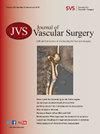Thirty-day outcomes from the Disrupt PAD BTK II study of the Shockwave Intravascular Lithotripsy System for treatment of calcified below-the-knee peripheral arterial disease
IF 3.6
2区 医学
Q1 PERIPHERAL VASCULAR DISEASE
引用次数: 0
Abstract
Background
Below-the-knee (BTK) lesions may be particularly challenging to treat owing to length, diffuse disease, and extent of calcification. Landmark interventional clinical studies have not reached consensus on the optimal standard of care for BTK lesions, and many published trials excluded patients with moderate or severe lesion calcification. Calcium modification with intravascular lithotripsy (IVL) was shown to be superior to percutaneous transluminal angioplasty in the femoropopliteal artery and successful in treating BTK lesions in pilot studies. The Disrupt BTK II study is a core laboratory-adjudicated, prospective, multicenter, single-arm study of patients with moderate to severely calcified BTK lesions treated with the Shockwave Medical Peripheral IVL System.
Methods
Disrupt BTK II enrolled 250 subjects with calcified infrapopliteal lesions and Rutherford category 3-5 presentation from 38 sites in the United States and Europe. The primary safety endpoint was major adverse limb events or postoperative death at 30 days, a composite of all-cause death, above-ankle amputation of the index limb, and/or major reintervention of the index limb involving an infrapopliteal artery. The primary effectiveness endpoint was procedural success, defined as ≤50% residual stenosis for all treated target lesions without serious core laboratory-adjudicated serious angiographic complications. The study used independent angiographic and duplex ultrasound core laboratories, and follow-up is planned through 2 years.
Results
A total of 305 lesions in 250 patients were treated with a procedural success of 97.9%. The mean target lesion length was 76 ± 65 mm, diameter stenosis was 78% ± 18%, and 84.8% had moderate or severe calcification as assessed by an independent angiographic core laboratory. After IVL, residual stenosis was reduced to 29%, and after optional postdilatation and/or stent implantation, to 26%. At 30 days, there were no deaths, major adverse limb event rate was 0.8%, and mean improvement in Vascular Quality of Life scores was 4.0 ± 5.0 (P < .0001). Of the patients with baseline wounds, 15.8% healed and 53.4% were improved at 30 days.
Conclusions
The Disrupt PAD BTK II study demonstrated that treatment with the Shockwave Medical Peripheral IVL System in patients with moderate-severe calcified lesions resulted in high procedural success, significant reduction in residual stenosis, improvements in patient quality of life, and wound healing, with minimal adverse events at 30-day follow-up.
冲击波血管内碎石系统治疗钙化性膝以下外周动脉疾病的 Disrupt PAD BTK II 研究的 30 天结果。
背景:膝关节以下(BTK)病变因其长度、病变弥漫性和钙化程度,治疗起来尤其具有挑战性。具有里程碑意义的介入临床研究尚未就治疗膝下骨关节病变的最佳标准达成共识,许多已发表的试验将中度或重度病变钙化患者排除在外。试验研究表明,血管内碎石术(IVL)的钙化修饰效果优于股动脉经皮腔内血管成形术(PTA),并能成功治疗 BTK 病变。Disrupt BTK II 研究是一项经核心实验室评审的前瞻性多中心单臂研究,研究对象是使用冲击波医疗外周 IVL 系统治疗中度至重度钙化 BTK 病变的患者:方法:Disrupt BTK II 从美国和欧洲的 38 个研究机构招募了 250 名患有钙化下髂病变和卢瑟福 3-5 类表现的受试者。主要安全性终点是30天内肢体主要不良事件(MALE)或术后死亡(POD),即全因死亡、指数肢体踝关节以上截肢和/或涉及髂下动脉的指数肢体主要再介入。主要有效性终点是手术成功率,定义为所有治疗过的靶病变残余狭窄率≤50%,且无核心实验室判定的严重血管造影并发症。研究使用了独立的血管造影和双相超声核心实验室,计划随访两年:250名患者共治疗了305个病灶,手术成功率为97.9%。经独立血管造影核心实验室评估,平均靶病变长度为 76 ± 65 毫米,直径狭窄率为 78 ± 18%,84.8%的病变存在中度或重度钙化。IVL 术后,残余狭窄率降至 29%,可选择后扩张和/或支架植入术后,残余狭窄率降至 26%。30天后,无死亡病例,MALE率为0.8%,VascuQoL评分的平均改善幅度为4.0 ± 5.0(PC结论:Disrupt PAD BTK II 研究表明,使用冲击波医疗外周 IVL 系统治疗中重度钙化病变患者的手术成功率很高,残余狭窄显著减少,患者 QoL 和伤口愈合得到改善,30 天随访时不良事件极少。
本文章由计算机程序翻译,如有差异,请以英文原文为准。
求助全文
约1分钟内获得全文
求助全文
来源期刊
CiteScore
7.70
自引率
18.60%
发文量
1469
审稿时长
54 days
期刊介绍:
Journal of Vascular Surgery ® aims to be the premier international journal of medical, endovascular and surgical care of vascular diseases. It is dedicated to the science and art of vascular surgery and aims to improve the management of patients with vascular diseases by publishing relevant papers that report important medical advances, test new hypotheses, and address current controversies. To acheive this goal, the Journal will publish original clinical and laboratory studies, and reports and papers that comment on the social, economic, ethical, legal, and political factors, which relate to these aims. As the official publication of The Society for Vascular Surgery, the Journal will publish, after peer review, selected papers presented at the annual meeting of this organization and affiliated vascular societies, as well as original articles from members and non-members.

 求助内容:
求助内容: 应助结果提醒方式:
应助结果提醒方式:


